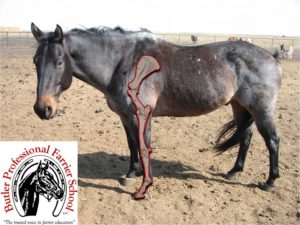Bone Development

Bones grow rapidly in horses. Growth plates in the bones close distally to proximally. Bone growth and development can be influenced positively by regular hoof care.
Horses have a unique skeletal structure that is highly developed at birth (compared to other species). A young foal can run with a herd within hours after birth. The skeleton creates the framework for the body to function. Or as my 6 year old daughter explained to me, “Without a skeleton, we’d all just be puddles.”
Horses’ skeletons develop rapidly. Whereas a human’s skeleton takes about 15 to 18 years to develop in height and about 21 years to fully develop in density, a horse finishes growing in height by approximately 3 years of age. Once the three year mark has passed, horses will not grow much more in height but may continue to grow or “fill out” until age 5.
A newborn foal’s lower limbs are longer in proportion to its body than a mature horse. The cannon bones only grow about 20 percent in length after birth, while the humerus and femur increase 100 percent in length (double in length). The percentage of growth change increases as you go up the limb. For example, in Quarter horses, if the knee joint is 15 inches off the ground at birth, it won’t be more than 18 inches off the ground in a mature horse. However, if the wither height is 36 inches at birth, the mature height will be about 60 inches. (Butler, Principles of Horseshoeing (P3), pp. 585).
Horses’ limbs are made up of long bones. Each of these long bones has growth plates (called epiphyseal plates). Bones grow outward (towards the plates). As the horse develops, the bone is influenced and modeled by the forces placed upon it. At a certain point, the growth plate closes and the bone is done growing in length. It will still develop in circumference and density.
The further the bone is away from the body, the sooner the growth plate closes. For example, the coffin bone growth plates (in the hoof) close around the time the foal is born. The short pastern bone growth plates close around 3 months. The femur growth plates close around 30 months and the humerus growth plates close around 36 months (or three years).
Bones of the lower limb may be heavily influenced by the forces placed upon them. Some horses are born with twisted or deviated limbs. As the horse bears weight unevenly on the crooked limbs, the bones can develop in an undesirable way. In the worst cases, pressure from uneven weight bearing can cause a decrease in blood circulation and damage to the bone itself.
To avoid situations where foals develop crooked legs, owners should take some precautions. Breeding horses with known limb defects will likely perpetuate the problem. Conformation is 65% heritable. Both the sire and the dam contribute to the gene pool. In other words, breeding a stallion with perfect conformation to a mare with crooked legs still has a high chance of producing a crooked legged foal. Owners should maintain a good breeding program as well as provide consistent hoof care for a young horse. In some cases, horses can develop a crooked limb while in the uterus (congenital defect). If this is the case, the owner should involve the farrier and veterinarian as soon as possible.
Horses should be trimmed (and shod when necessary) by a competent farrier on a regular schedule. Too often, neglect can lead to undesirable bone remodeling. Unequal pressure and stresses on the bone column result in unequal growth and strength. Soundness is the result of uniform weight bearing on the bones by consistently balancing the feet through regular trimming and shoeing. Simply maintaining a horse’s hoof care from an early age can prevent the need for radical trimming or shoeing later.
In some severe cases of crooked limb development, therapeutic trimming and shoeing can be very useful. When a bone is developing crooked, due to unequal weight bearing, a shoe may be placed under the center of gravity to take pressure off of certain areas of the bone and allow the bone to grow straight. This must be done before the epiphyseal growth plates close. Therapeutic trimming and shoeing is not a guarantee. Some horses seem to “straighten up” better than others. It is also important to remember that even though a horse might be straightened up, the genetic material to pass on the condition is still present. If a horse has had corrective shoeing or surgery done to improve conformation, the owner should use good judgment about breeding that horse. The owner should notify a potential buyer of corrective procedures if the animal is to be sold.
Related Posts
-
There is a tendency today for people to get all they can whe...Mar 13, 2012 / 0 comments
-
What should horse owners expect from their farrier? You, the...Mar 28, 2019 / 0 comments
-
Farriers are presented with different horse feet scen...Oct 27, 2016 / 0 comments
Blog Categories
- Anatomy
- Best Business Practices
- Conformation
- Current Events
- Customer Service
- Draft Horse Shoeing
- Equine Soundness
- Essential Anatomy Kit
- Farrier Careers
- Farrier training
- Foal soundness
- Horse Care
- Horse Foot Care
- Horse Owner Tips
- Horsemanship
- Horseshoeing
- Horseshoeing History
- Iron and Forge Work
- Student Spotlight
- Uncategorized
- Veterinary Care
Blog Archives
Contact Us
Butler Professional Horseshoeing School
495 Table Road
Crawford, NE 69339
(800) 728-3826
jacob@dougbutler.com
Subscribe to Our Blog
Get Our Free e-Book!
If you think you want to become a farrier (or know someone who does), this book can help you make that decision. Horse owners will learn the importance of choosing a qualified farrier and how to select the “right” one.
[ Get the e-Book Now! ]
- Follow:
